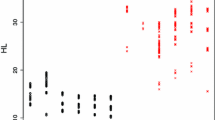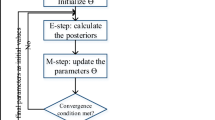Abstract
For several years, model-based clustering methods have successfully tackled many of the challenges presented by data-analysts. However, as the scope of data analysis has evolved, some problems may be beyond the standard mixture model framework. One such problem is when observations in a dataset come from overlapping clusters, whereby different clusters will possess similar parameters for multiple variables. In this setting, mixed membership models, a soft clustering approach whereby observations are not restricted to single cluster membership, have proved to be an effective tool. In this paper, a method for fitting mixed membership models to data generated by a member of an exponential family is outlined. The method is applied to count data obtained from an ultra running competition, and compared with a standard mixture model approach.







Similar content being viewed by others
Notes
Note that these examples use different terminology to describe their methods: latent Dirichlet allocation (Blei et al. 2003), latent process decomposition (Rogers et al. 2005) and grade of membership (Erosheva et al. 2007; Gormley and Murphy 2009). Each of the models allocate individual observations to multiple components in a similar fashion, which we refer in general to as a mixed membership model (Erosheva et al. 2004).
A version of this data is available at http://mathsci.ucd.ie/~brendan/data/24H.xlsx.
References
Abramowitz M, Stegun IA (1965) Handbook of mathematical functions: with formulas, graphs, and mathematical tables, 1st edn. Dover Publications, USA
Airoldi EM, Blei D, Erosheva E, Fienberg SE (2014) Introduction to mixed membership models and methods. In: Airoldi EM, Blei D, Erosheva E, Fienberg SE (eds) Handbook of mixed membership models, Chap. 1. Chapman & Hall/CRC, Boca Raton
Airoldi EM, Fienberg SE, Joutard C, Love T (2006) Discovering latent patterns with hierarchical Bayesian mixed-membership models. Technical report, Carnegie Mellon University, School of Computer Science, Machine Learning Department. Report no CMU-06-101. http://ra.adm.cs.cmu.edu/anon/ml/CMU-ML-06-101.pdf
Airoldi EM, Fienberg SE, Joutard C, Love T (2007) Discovering latent patterns with hierarchical Bayesian mixed-membership models. In: Poncelet P, Teisseire M, Masseglia F (eds) Data mining patterns: New methods and applications, Chap. 11. Idea Group Inc., Calgary
Baudry JP, Raftery AE, Celeux G, Lo K, Gottardo R (2010) Combining mixture components for clustering. J Comput Gr Stat 19(2):332–353
Beal M (2003) Variational algorithms for approximate Bayesian inference. Ph.D. dissertion. University College London
Bensmail H, Celeux G, Raftery AE, Robert C (1997) Inference in model-based cluster analysis. Stat Comput 7:1–10
Biernacki C, Celeux G, Govaert G (2000) Assessing a mixture model for clustering with the integrated completed likelihood. Pattern Anal Mach Intell IEEE Trans 22(7):719–725. doi:10.1109/34.865189
Bishop CM (2006) Pattern recognition and machine learning. Springer, Secaucus
Blei DM, Lafferty JD (2006) Dynamic topic models. In: Cohen W, Moore A (eds) Proceedings of the 23rd international machine learning conference. http://icml.cc/2016/awards/dtm.pdf. http://dl.acm.org/citation.cfm?id=1143859
Blei DM, Lafferty JD (2007) A correlated topic model of science. Ann Appl Stat 1(1):17–35
Blei DM, Ng AY, Jordan MI (2003) Latent Dirichlet allocation. J Mach Learn Res 3:993–1022
Dempster AP, Laird NM, Rubin DB (1977) Maximum likelihood from incomplete data via the EM Algorithm. J R Stat Soc Ser B (Methodol) 39(1):1–38. doi:10.2307/2984875
Erosheva EA, Fienberg SE, Joutard C (2007) Describing disability through individual-level mixture models for multivariate binary data. Ann Appl Stat 1(2):502–537
Erosheva EA, Fienberg SE, Lafferty J (2004) Mixed-membership models of scientific publications. Proc Natl Acad Sci USA 101:5220–5227
Everitt BS, Hand DJ (1981) Finite mixture distributions. Chapman and Hall, London
Fraley C, Raftery AE (2002) Model-based clustering, discriminant analysis, and density estimation. J Am Stat Assoc 97(458):611–631
Galyardt A (2014) Interpreting mixed membership models: Implications of Erosheva’s representation theorem. In: Airoldi EM, Blei D, Erosheva E, Fienberg SE (eds) Handbook of mixed membership models, Chap. 11. Chapman & Hall/CRC, London
Gormley C, Murphy TB (2009) A grade of membership model for rank data. Bayesian Anal 4(2):265–296
Hill MO (1973) Diversity and evenness: a unifying notation and its consequences. Ecology 54(2):427–432
Manrique-Vallier D (2014) Longitudinal mixed membership trajectory models for disability survey data. Ann Appl Stat 8(4):2268–2291
McLachlan G, Peel D (2002). Finite mixture models. Wiley, New York
Ormerod JT, Wand MP (2010) Explaining variational approximations. Am Stat 64(2):140–153
Rogers S, Girolami M, Campbell C, Breitling R (2005) The latent process decomposition of cDNA microarray datasets. IEEE/ACM Trans Comput Biol Bioinf 2:2005
Schwarz G (1978) Estimating the dimension of a model. Ann Stat 6(2):461–464
van den Boogaart KG, Tolosana-Delgado R (2008) Compositions: A unified r package to analyze compositional data. Comput Geosci 34(4):320–338
Vermunt JK, Magidson J (2002) Latent class cluster analysis. In: Hagenaars JA, McCutcheon A (eds) Applied latent class analysis. Cambridge University Press, Cambridge, pp 89–106
Wang C, Blei D (2013) Variational inference in nonconjugate models. J Mach Learn Res 14:1005–1031
White A, Chan J, Hayes C, Murphy TB (2012) Mixed membership models for exploring user roles in online fora. In: Ellison N, Shanahan JG, Tufekci Z (eds) Proceedings of the sixth international AAAI conference on weblogs and social media (ICWSM 2012), pp 599–602. http://www.aaai.org/ocs/index.php/ICWSM/ICWSM12/paper/view/4638
Acknowledgments
This work is supported by Science Foundation Ireland under the Clique Strategic Research Cluster (08/SRC/I1407) and Insight Research Centre grant (SF1/12/RC/2289).
Author information
Authors and Affiliations
Corresponding author
Rights and permissions
About this article
Cite this article
White, A., Murphy, T.B. Exponential family mixed membership models for soft clustering of multivariate data. Adv Data Anal Classif 10, 521–540 (2016). https://doi.org/10.1007/s11634-016-0267-5
Received:
Revised:
Accepted:
Published:
Issue Date:
DOI: https://doi.org/10.1007/s11634-016-0267-5




